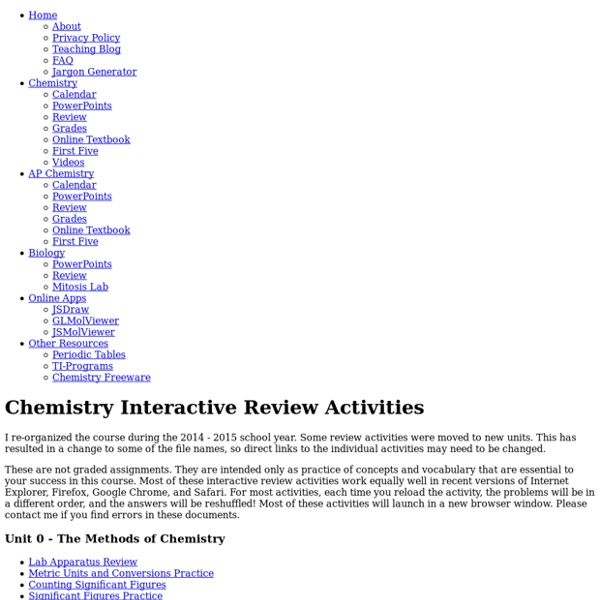Classic ChemBalancer - Welcome
This is the classic version of Chembalancer that teaches you how to balance equations for the first time. To play it, just press the "Start Game" button above. To play the other versions, click here. Teachers: Classic Chembalancer is for students who are learning to balance equations for the first time. Awards for original Classic Chembalancer site © 2005 Sulan Dun.
Chemical & Engineering News: What's That Stuff?
You might ask yourself... What's That Stuff? Ever wondered about what's really in hair coloring, Silly Putty, Cheese Wiz, artificial snow, or self-tanners? C&EN presents a collection of articles that gives you a look at the chemistry behind a wide variety of everyday products. Sort: Alphabetically (Text Only) | Most Recent
College Lifestyles
Periodic Table of Elements and Chemistry
chemsoc - for everyone interested in the chemical sciences
We want everyone to experience the excitement and value of the chemical sciences. Our members and supporters reach out to connect people - from schoolchildren to scientists to political leaders - with chemistry. Whether you want to attend or run an event, set up a meeting or spend a few minutes writing an email, find out in this section how to get involved. Also in Campaigning & outreach: CampaigningFind out about our current campaigns and see how you can get involved in a way that suits you. PolicySee how we help to shape policy debates by providing expert information and leading the development of policy in key areas. OutreachFind out what we are doing to bring the chemical sciences to a wide range of different audiences, and how you can get involved. Tackling global challengesChemistry can help us avoid dangerous climate change, generate energy sustainably, feed the world, and tackle disease and illness.
HandsOn Greater Richmond
AP Chemistry Review Activities
AP Chemistry Interactive Review Activities In keeping with the new framework for AP Chemistry beginning in 2013 - 2014, I am indicating here if the topic to which a review activity relates has been dropped from the curriculum. It will be identified as excluded (Excluded) to indicate that the College Board has specifically excluded it. I will leave the reviews here, however, in case some of you find them useful. These are not graded assignments. Each time you reload the activity, the problems will be in a different order, and the answers will be reshuffled!
Top 10 Amazing Chemistry Videos | Wired Science
Fiery explosions, beautiful reactions, and hilarious music videos are great reasons to be excited about chemistry. Here are some of our favorites. 10. Thermite vs. Liquid Nitrogen The British science show Brainiac asked one of the greatest scientific questions of all time: can liquid nitrogen freeze molten iron? 9. 8. 7. 6. 5. 4. 3. 2. 1. If you have not had enough yet, check out the brilliant collection of Edward Kent.
Chemistry | 5.112 Principles of Chemical Science, Fall 2005 | Video Lectures | Lecture 26: Molecular Orbital Theory
Chemistry Now
The National Science Foundation (NSF) has joined forces with NBC Learn and the National Science Teachers Association (NSTA) to celebrate the International Year of Chemistry by creating "Chemistry Now"--a weekly, online video series that uncovers and explains the science of common, physical objects in our world and the changes they undergo every day. The series also looks at the lives and work of scientists on the frontiers of the 21st century... More. This video explains and illustrates the molecular structure of sodium chloride (NaCl) crystals; the structure and symmetry of crystal lattices; and why one crystalline solid, salt, melts another, ice.
Database of Periodic Tables
There are hundreds of periodic tables in web space, but there is only one comprehensive database of periodic tables & periodic system formulations. If you know of an interesting periodic table that is missing, please contact the database curator: Dr Mark R Leach. Harrington Periodic Tables So we start this effort tabula rasa (without preconceived ideas). 1) All atoms have a default "common denominator" structure at 270 mass units, irrespective of the element under discussion. Therefore, no elements seen as wisps and glints past this point are of consequence. Top of Page KAS Periodic Table The KAS periodic table reproduces and depicts the nuclear properties of chemical elements. The Segre Chart is based on the number of protons, Z, and the number of neutrons, N. Location that remains near the Neutron Dripline of element. Read more here, here and here. Sensu or Fan Periodic Table By NAWA, Nagayasu – A Japanese schoolteacher and periodic table designer – a "Sensu" or fan periodic table:



